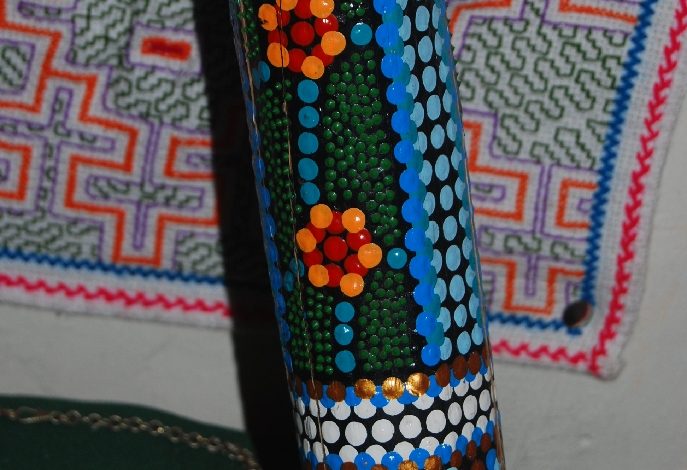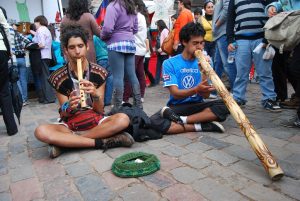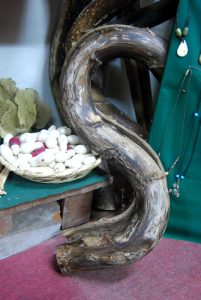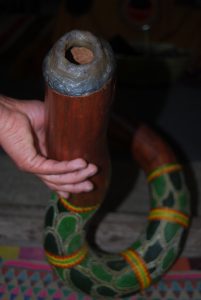
A crossroads, Cuzco has a musical culture that is constantly expanding and growing. Its young musicians learn forms an styles from all over the world. While in other cities this may be because of Youtube, CDs, and the radio, in Cuzco it is also because of traveling musicians who stop an perform.
As a result, the Australian aboriginal didgeridoo can now be heard on the streets, in some clubs, and in homes in Cuzco. While an instrument and its music may have many ways of arriving in Cuzco, in this case it came with Latin American followers of reggae, a religious, musical culture that continues to evolve beyond its Jamaican roots, especially as they sink into the new earth of Cuzco.
The didgeridoo is a natural trumpet made in Cuzco from the long stem of a maguey’s flower. As its name suggests, this plant is not native to Peru, but to Mexico, and came in earlier waves of foreign migration. Nevertheless it is now thoroughly naturalized in the landscape around Cuzco with its wide flat rosette of large leaves and its once a lifetime stalk of flowers that rises twenty to thirty feet in the air.
Like the maguey, long trumpets made of it, didgeridoos, claim a place in Cuzco now. They have become the most important instrument for use in the spiritual sessions surrounding the use of wachuma (the San Pedro Cactus) and ayahuasca. They appear in association with a djembe drum from West Africa originally. In Cuzco they call it a “yemben”. It is known as the drum that calls people to gather in peace.” In these session where people take wachuma or ayahuasca to learn from the spirits of the plants, the naturalness of these instruments and their traditional associations with spirits and spirituality make them important. Other natural instruments are also welcome.

The didgeridoo is an ancestral aerophone instrument. Although originally from northern Australia, the didgeridoo has become globally associated with ancestral authenticity, at the same time many aboriginals are frustrated with the sacred instrument’s appropriation. In Australia, the instrument is thousands of years old according to the interpretation of evidence from rock art there.

In the Andes as it joins native hallucinogens in a context where lowland groups would use bull roarers and had traditions of very long flutes associated with maleness and the world of spirits.
In our city you can find didgeridoos for sale in in some music stores as well as in stores dedicated to mystical and spiritual practices. You can also see the didgeridoo performed in reggae concerts. It comes in various forms, such as straight, curved, or like the shape of a snake. This wind instrument is one of the most seen in reggae discotheques within the city of Cuzco, since it is a musical background for the various songs.
Sometimes you will see artists sitting in the streets and playing didgeridoo to please passersby in hopes of receiving money. When people hear the vast range of notes and the different sounds of the didgeridoo they are surprised and they leave tips. Generally these musicians are from other places and earn money this way to be able to travel.

To be able to play the didgeridoo you must control your breathing. At first it seems very complicated but with practice it becomes easy. The fine didgeridoo musicians know the exact way to push their lips against the opening at the top of the instrument, the different kinds of buzzes and other actions they do, as well as relying on their excellent musical memory to create complex inter-weavings of sound and melody.
This instrument is known in Cuzco as one of the fruits of the maguey. When the plant blooms it leaves a long stem that takes many different forms. Sometimes long and straight and sometimes curved. Sometimes it is thick and sometimes thin. We use this stalk to make our didgeridoos.
To make a didgeridoo you must first go to the places outside the city on the mountains or hillsides where this plant grows. After identifying and then cutting a stalk you have to let it thoroughly dry, at least for a month, so that it would warp or get deformed.
Once it is dried you have to slice it into two long halves and then scrape out all the middle of the stalk. You leave it completely smooth like a tube. After all this arduous work, you have to glue it back together with wood glue and tie it with rubber thongs so that it does not come apart.
Once completely dry you smooth it out on the outside and you can paint it with acrylic paints. The designs depend one ones own creativity. However, the majority of the craftsmen of San Blas paint them with the Andean trilogy, the condor, puma, and serpent.

The sounds that come from these trumpets are really unbelievable. They are strange and translate into different dimensions. They seem to be Amazonian melodies that make you travel deep into the jungle.
The first time we heard the sound of a didgeridoo was in a restaurant. The sound surprised us. We heard attractive but very different sounds that made us feel new sensations. A group of musicians who were traveling while doing music to support themselves was performing. The best part was that the sounds were natural and they made us feel good.
These days we often have travelers come to Cuzco bringing these instruments. Each person brings their own instrument. The set up in our streets, especially near the Plaza of San Blas and play to make money. We call this “parchar”, to “patch”, a way of bridging over needs so that they can continue traveling and getting to know new cities.
This is how the didgeridoo came to Cuzco, in the hands of travelers from other parts of Latin America, especially from the north, who brought it with them. Now, however, many people in Cuzco also play the instrument.





Nothing like a real Aussie one.
The white ants hollow them before they’re removed from the ground, so they are naturally hollowed.
Finding them is part of the art.
They come straight from the bush as a totally natural instrument.
But hey, we dont have curly ones like you guys make.